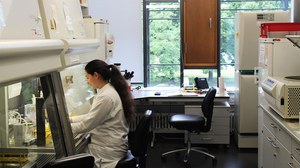Research Interests
The human brain, even though it represents only 2% of the body weight, is responsible for 20% of the total oxygen consumption. This illustrates the great energy need of the nervous system. Thus, highly energetic compounds must be delivered to the neurons. This is hindered by the blood-brain barrier (BBB) that protects the nervous system from harmful substances, but at the same time blocks paracellular diffusion of metabolites. As a consequence, the BBB-forming cells express a variety of transport proteins to enable import of essential compounds and export of waste products. One feature of many neurodegenerative diseases is disturbed neural metabolism. We aim to better understand metabolic interactions taking place in the nervous system. We use the genetically accessible model organism Drosophila melanogaster to study neural carbohydrate metabolism in detail. Our work focuses on how the transport of metabolites and their distribution within the nervous system are organized. Recently, we showed that in Drosophila carbohydrates are taken up from circulation by the BBB-forming glial cells and are metabolized primarily by glial cells via glycolysis. The glia subsequently secretes alanine and lactate, which can fuel the neuronal citrate cycle and respiratory chain. Thus, a metabolic division of labor between glial cells and neurons takes place.
We are currently trying to understand which transporters are needed to distribute carbohydrates, lactate and alanine between the different neural cell types. To this end, we analyze transporter expression and specificities in the nervous system. We further aim on understanding how the amounts of carbohydrate taken up from circulation and of lactate/alanine transferred to the neurons are dynamically adapted to the neuronal needs. We use the genetic strength of Drosophila to unravel the underlying regulatory mechanisms that allow neuron-glia communication and modulate nutrient uptake and distribution.
 © Amac Garbe
© Amac Garbe
More Information
- more information coming up


